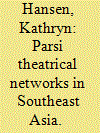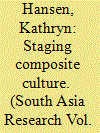| Srl | Item |
| 1 |
ID:
157733


|
|
|
|
|
| Summary/Abstract |
Rangoon circa 1900 was known as ‘one of the best show towns in the East’. As the capital city of Burma, then ruled from Calcutta as a province of India, it was home to more Indian nationals than Burmese. In this cosmopolitan context, two vernacular arts complexes — the Parsi theatre of India and the popular zat-pwe of Burma — flourished, competed, and converged. This article documents the 55-year long engagement of Parsi theatre in Burma within the larger history of global theatrical flows in the Indian Ocean. It highlights the story of Dosabhai Hathiram, a theatre man who rooted himself in Rangoon his entire life. And it asks, why was Parsi theatre celebrated elsewhere in Southeast Asia as a vector of modernity, and yet in Burma it left scarcely a trace behind?
|
|
|
|
|
|
|
|
|
|
|
|
|
|
|
|
| 2 |
ID:
091725


|
|
|
|
|
| Publication |
2009.
|
| Summary/Abstract |
Both the rural-based Nautanki and its urban counterpart, the Parsi theatre, remain part of the cultural scenario of modern India and continue to contribute to the ongoing negotiation of India's composite culture. Part of the appreciation of these older stylized theatre genres comes from awareness of their hybrid character. As emblems of composite culture, these theatrical traditions remind viewers of a popular secular outlook that is still within reach. This article discusses two performances observed during 2004 in New Delhi, of Amar Singh Rathor and Yahudi ki Larki, both canonical popular texts. It is argued that the revival of these plays owes much to their ability to serve as allegories within the current polarized cultural and political climate. The discussion suggests the continuing potential of the impulse to counter neo-nationalist ideology by means of popular media such as Nautanki and Parsi theatre.
|
|
|
|
|
|
|
|
|
|
|
|
|
|
|
|